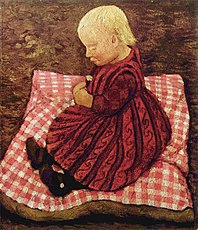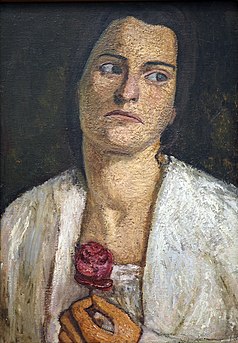Paula Modersohn-Becker ( 1876 –1907), Haus Paula Becker, Bremen. Bremen Kunsthalle. 來不及跟謝立沛老師說的布萊梅女藝術家的故事
https://www.facebook.com/hanching.chung/videos/953241808976345
Portraits[edit]
Elsbeth Modersohn on a red pillow (c. 1904) | Old Peasant Woman (c. 1905) | Klara Rilke-Westhoff (1905) Hamburger Kunsthalle | Elsbeth Modersohn with a rabbit(1905) | Lee Hoetger with flower (1906) | Lee Hoetger and her sister(1906-7) |
Paula Modersohn-Becker (8 February 1876 – 20 November 1907)[1] was a German Expressionist painter of the late 19th and early 20th century. Her work is noted for its intensity and its blunt, unapologetic humanity, and for the many self-portraits the artist produced, including nude self-portraits. She is considered one of the most important representatives of early expressionism, producing more than 700 paintings and over 1000 drawings during her active painting life.[2] She is recognized both as the first known woman painter to paint nude self-portraits, and the first woman to have a museum devoted exclusively to her art (the Paula Modersohn-Becker Museum, founded 1927).[3] Additionally, she is considered to be the first woman artist to depict herself both pregnant and nude and pregnant.[2]
Her career was cut short when she died from postpartum embolism at the age of 31.
Paula's death was likely due to deep venous thrombosis (DVT), a complication of pregnancy that is relatively common when women are set to bed for a long time after delivery, as was customary practice at that time. Apparently, a thrombus had formed in her leg, and with her mobility, broke off and then caused her death within hours.[13]Paula 的死亡很可能是由於深靜脈血栓形成 (DVT),這是一種妊娠並發症,當婦女在分娩後長時間臥床時相對常見,這是當時的習慣做法。顯然,她的腿上形成了血栓,隨著她的活動能力,血栓脫落,然後在數小時內導致她死亡。 [13]








沒有留言:
張貼留言